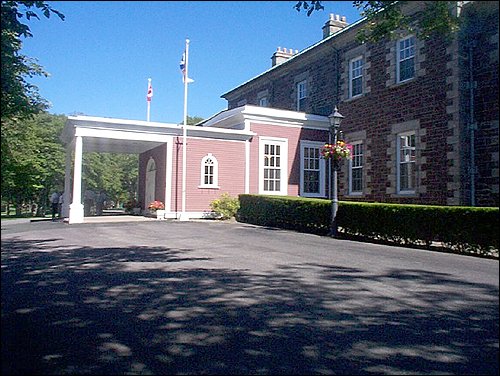Background and Construction
Background
The post of Governor of Newfoundland, an administrative post with specific instructions from the Crown, did not exist until 1729 despite the fact that the island had been the resort of fishermen for some two centuries. The various persons who used the title before that time, such as John Guy and Richard Whitbourne, had been governors only of specific colonies and were little more than branch managers of commercial enterprises. The appointment of a naval governor brought an important measure of administrative order to a territory that had, until then, been fairly disorderly. But even these naval governors had their limitations. They were only present for the summer fishery so their effect was somewhat transient. And without some kind of permanent establishment, some security against the vagaries of one's neighbours, Newfoundland was only going to have hesitant growth. The building of Fort Townshend and the creation of the judiciary at the end of the 18th century helped shape this permanence.
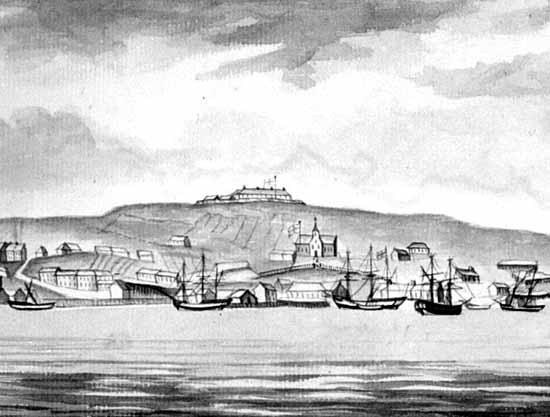
The First Government House
The first Government House was built in Fort Townshend. But Governor Richard Edwards (1779-82) may have occupied another house while waiting for it to be completed. According to Bishop Howley, this was really the "first Government House." It lay on Stripling's Plantation between what is now Gower and York streets. No record of it survives, save Howley's description: "not of any very elaborate or gubernatorial pretensions [it] was, nevertheless, something of a more durable and expensive character than the ordinary wooden dwellings of the time, as the oaken beams still visible [c. 1886] can testify. It is of very remote antiquity" (Howley 210).
The building in Fort Townshend, finished in 1781, was intended as a summer house for the governors and remained the official residence until the present structure was completed in 1831. A wooden five-bay Georgian house of the simplest form, it was in keeping with the general architecture of the fort. It was apparently enlarged in 1812 so that the principal rooms became major spaces for entertainment. But it was never very comfortable in winter - a point made with some force when the first resident governor, Francis Pickmore, died there in 1818. A poorly-clad, drafty house into which the snow drifted in winter, it is not surprising that Pickmore objected to being accommodated there. What is surprising is that subsequent governors accepted the post with such poor living quarters.
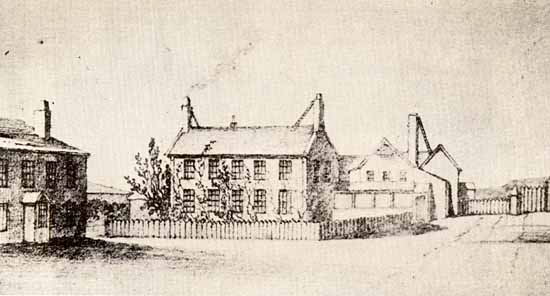
During the French Revolutionary and Napoleonic wars, Newfoundland entered a new phase of development. In the last quarter of the 18th century the fishery had begun to fall into more local hands, in the sense that firms now established Newfoundland bases and permanent settlements. This saw fruition in the first two decades of the 19th century. Permanent settlement developed with immigration, and so did agitation for local control of local affairs. Many of the governors of the time were enlightened men who, within the limits of their instructions, encouraged progressive measures. Their presence, the exercise of their authority, and the sense of stability such authority conveyed, all served to build the confidence of those who occupied the land. The building of a very substantial Government House was a tangible expression of this growing sense of permanence.
Construction
Government House was a by-product of the wave of administrative initiatives that took place during the 1820s. The royal charter of 1825 bestowed official colonial status, and the island's first civil governor, Sir Thomas Cochrane, ushered in a new constitutional era. Faced with a political atmosphere marked by high expectations for economic and social progress, Cochrane seemed to be in step with the times. As a 42 year old naval captain, he was also well suited to the routine of pomp and ceremony that accompanied the office of governor. The construction of Government House was meant to reflect the proper status of the governor of a territory that was now an official British colony and an important part of the Empire.
Cochrane's Costly Plans
These functions, both ceremonial and political, made Government House an important place in Newfoundland history, and the money which Cochrane lavished on its construction indicates that he saw the building as having such a purpose. The scale of the building, the treatment of its grounds, the size of its property, its location in the town all had their effect.
But it was not an effect without a cost. Cochrane's original plans were to build something in the manner of Admiralty House at Plymouth. The government demurred, until Cochrane persuaded them that a climate which forced an indoor life required more indulgence in interior amenities. However, when one looks at the escalation in costs, it is clear that Cochrane's notion of indulgence was self-indulgence and a progression from an original estimate of £8,778 to a final cost of £38,000 - and a court of inquiry into that cost.
One instance of this will make the point. The three principal rooms, the dining, drawing and ballrooms, adjoin one another and face south onto the lawn and the town. They were to have their fireplaces on the walls that separated them but Cochrane, after the massive chimneys had been built, decided he wanted double doors between these rooms - presumably to permit a grand progress between the rooms. He had his way, to the frustration of the engineers in charge of the project.
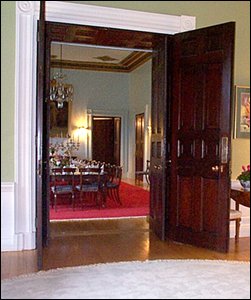
Work on the mansion began in 1827 and, by the time it was finished in 1831, the plans had been "improved" in a number of costly ways: adding to the size of the wings and the porch, putting columns and a skylight in the entrance hall, and creating a more elaborate staircase.
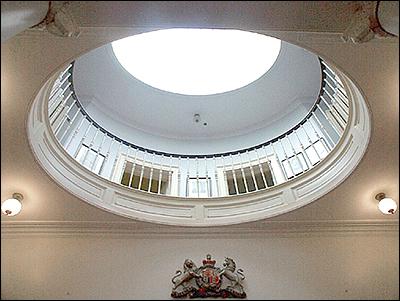
Describing the Mansion
How does one describe the mansion stylistically? It is a handsome if plain Georgian mansion. Constructed of masonry, it has a centre block and two wings under hipped roofs. While the interior reception rooms are spacious and impressive, the exterior does not seem to have been fully finished. It lacks the details usual for a house of this type, and a semi-circular portico to frame the entrance, as originally planned, was never built. Instead, a porch has been extended into the driveway to provide some protection from the north winds. The trees and gardens surrounding the house now soften the severity of its exterior, and the harsh words of earlier critics, such as the historian D.W. Prowse, who thought it "a huge pile of unredeemed ugliness" are seldom, if ever, repeated today.
